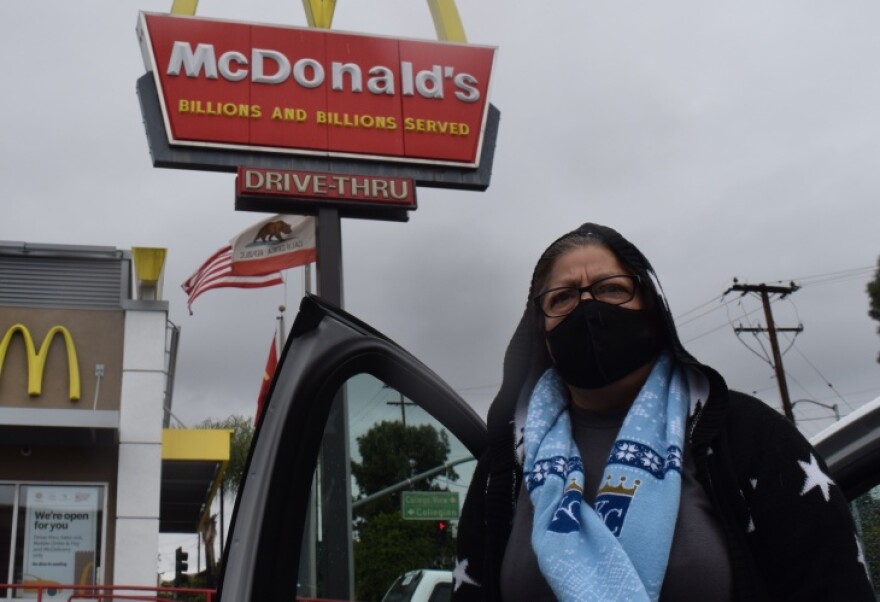Truth matters. Community matters. Your support makes both possible. LAist is one of the few places where news remains independent and free from political and corporate influence. Stand up for truth and for LAist. Make your year-end tax-deductible gift now.
For LA's Essential Workers, The Housing Crisis Has Become A Health Crisis

Our news is free on LAist. To make sure you get our coverage: Sign up for our daily coronavirus newsletter. To support our non-profit public service journalism: Donate Now.
L.A.'s essential workers face a higher risk of coronavirus infection on the job. Many of them are coming home to overcrowded housing conditions, putting their family members at risk, too.
Southern California's unaffordable housing costs have forced workers such as McDonald's employee Laura Pozos to cram into tight quarters. She lives in a three-bedroom house in Commerce with 10 other family members.
"Rents are really expensive, and we don't have enough money for all of us to pay for separate homes," Pozos said.
AT RISK ON THE JOB -- AND BRINGING THAT RISK BACK TO A CROWDED HOME
As a food service worker, Pozos is among those officially designated by the state of California as an "essential" worker. In late March, she worked in close proximity with a co-worker who was later hospitalized with COVID-19.
DON'T MISS ANY L.A. CORONAVIRUS NEWS
Get our daily newsletters for the latest on COVID-19 and other top local headlines.
Terms of Use and Privacy Policy
Pozos said the Monterey Park location where she works did not provide workers with masks, adequate hand sanitizer or the ability to maintain six feet of distance from other employees.
Pozos walked off the job with her co-workers to demand more protective gear. She said she worried about getting sick at work and spreading the illness at home.
"I was scared of infecting my whole family and putting all the people here at risk, including my daughters and grandchildren," Pozos said.
McDonald's representative Mike Vizza emailed us a statement saying that after the company found out about the hospitalized worker in Monterey Park, employees were asked to stay home with pay.
"As soon as we were notified of this confirmed case on April 8, we conducted a thorough sanitization procedure per CDC guidelines and notified local health authorities," Vizza said.
Pozos still doesn't feel safe returning to work. She's currently seeking paid family leave. She said other family members are still working in essential jobs, and they've developed a routine for re-entering the house after work.
"When we're coming home, we tell the girls, 'Shut yourselves in your room until we can come in and bathe.' And then we can see them," she said.
CROWDED HOUSING LEADS TO A PUBLIC HEALTH 'MULTIPLIER EFFECT'
According to U.S. Census data, L.A. has the most severely overcrowded housing of any large metro area in the country. Residents are squeezing into small homes, sometimes using living rooms, kitchens and other spaces as makeshift bedrooms.
Overcrowded housing is not a new problem in L.A. But now it could make controlling the spread of infection more difficult.
A recent analysis from the Public Policy Institute of California (PPIC) finds that California's essential workers are more likely than nonessential workers to live in crowded housing. The problem is especially pronounced for lower-income workers who often have no choice but to work in close proximity with others.
"There is this kind of multiplier effect of people who are out in the community, and then bringing back risk to additional people in their crowded living conditions," said PPIC research fellow Paulette Cha.
PPIC researchers found that 21% of essential workers in L.A. County live in overcrowded housing. Orange County has a similarly high rate at 20%.
Cramped living conditions are even more common for certain types of essential workers. For instance, 29% of California food prep workers deal with overcrowding at home.
Overcrowding also affects some ethnicities more than others, with 18.4% of Latino households statewide living in overcrowded conditions compared with just 2.4% of white households.
A recent UC San Francisco study found that among a sample of San Francisco Mission District residents and workers who tested positive for COVID-19, 95% were Latino. Many reported that they were unable to work from home.
"This particular public health crisis of COVID-19 is something that is spread through close contact," Cha said. Given that California's housing is often so crowded, she said "the housing crisis is now becoming part of this larger public health crisis."
QUARANTINE IN CLOSE QUARTERS
Workers now face tough choices when they get sick. For some, quarantining at home in isolation from other family members is physically impossible.
One Domino's worker in L.A. said his family even paid for a hotel room so he could quarantine in isolation for 12 days after testing positive.
The state of California has launched a program that provides hotel rooms to frontline health care workers, in order to minimize their risk of infecting family members at home. But no such program exists for other essential workers.
"More and more health care workers are taking advantage of this service and we are constantly evaluating the needs on the frontlines," said a spokesperson for California's Department of General Services.








